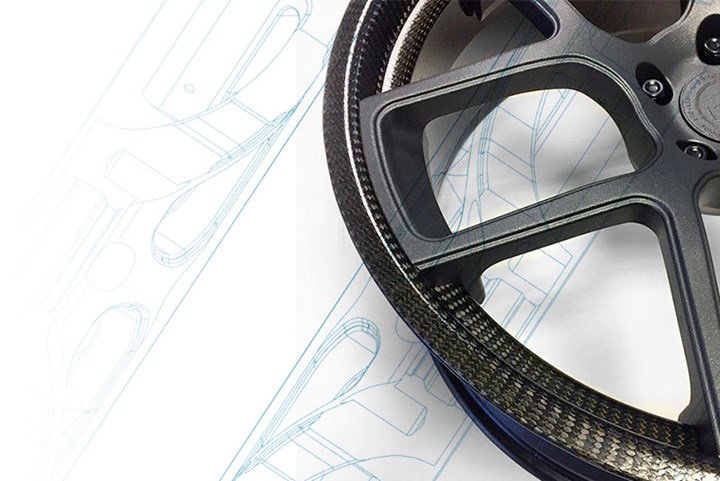Carbon ThreeSixty, Leonardo, NCC all-composite helicopter wheel project takes off
The 18-month project will design, develop and manufacture 12 fully tested ultra-low mass, robust, proof-of-concept CFRP wheels for rotary wing aircraft.

All photo credit: Carbon ThreeSixty
Advanced composite structure specialist Carbon ThreeSixty (Chippenham, U.K.) is now leading its new NATEP project, co-funded by Innovate UK, the U.K.’s innovation agency, to design, develop and manufacture an ultra-low mass, robust, proof-of-concept carbon fiber-reinforced plastic (CFRP) wheel for rotary wing aircraft.
The project, which began on Jan. 1 of this year will run for the next eighteen months. Consortium partners Leonardo (Rome, Italy) and the National Composites Centre (NCC, Bristol, U.K.) will leverage their expertise, with an aim to improve performance, safety and full ownership cost.
According to Carbon ThreeSixty, the current global market for helicopter wheels uses metallic light-alloy materials, usually aluminum or magnesium. While these offer sufficient strength and stiffness from a relatively low density, a wheel made of CFRP will offer significantly enhanced mechanical properties at approximately half the density of metallic wheels.
“The application of advanced composite materials and processes specifically to aerospace wheels is a highly innovative step,” says Ed Allnut, managing director of Carbon ThreeSixty. “Our experience with other composite wheel applications has shown that weight savings of 30-40% are achievable over forged aluminum solutions. We believe the key selling point, however, will be the improvements in fatigue life and failure mode which will extend life and improve safety.”

Weight reductions will enable airframers to deliver efficiency, range and payload improvements and provide an option for lower power density propulsion systems, such as battery-electric. In addition to improved corrosion resistance and NVH (noise, vibration and harshness) performance, composite wheels will be interchangeable with existing wheels, making them suitable for retrofit applications.
Carbon ThreeSixty says the project will use cutting-edge composite manufacturing technology such as tailored fiber placement (TFP), braiding and out-of-autoclave (OOA) processes to ensure repeatability and scalability.
“Composite wheels have only become viable in the last 10 years due to improvements in resin system toughness, lower carbon fiber prices and improvements in-process automation. We can see this in the automotive wheel market, where they are now proven,” says Alex Doyle, technology project lead of NCC. “However, aerospace applications are more challenging. The shift in cost, combined with the technical improvements are the reason why now is the time composite wheels are feasible for aerospace rotorcraft applications.”
The scope of the project reportedly covers the specification, design, development, manufacture, inspection and testing of a proof-of-concept helicopter wheel, considering full aerospace requirements in line with the specification provided by Leonardo for an undisclosed platform.
“We are very keen to be involved in developing this technology. Composites are expected to save around 1.5 kilograms over each 5-kilogram alloy wheel. This 6-kilogram weight saving overall represents almost 1,000 gallons of fuel saved over a typical 12,000 hour service life and equates to around 12 tonnes of CO2,”Adrian Smith, R&T Portfolio Delivery at Leonardo Helicopters UK, says.
The project is expected to last around 18 months, with a total budget of around £250K. Deliverables will include 12 fully tested proof-of-concept wheels, and a methodology for design and manufacture.
Related Content
-
The potential for thermoplastic composite nacelles
Collins Aerospace draws on global team, decades of experience to demonstrate large, curved AFP and welded structures for the next generation of aircraft.
-
Sulapac introduces Sulapac Flow 1.7 to replace PLA, ABS and PP in FDM, FGF
Available as filament and granules for extrusion, new wood composite matches properties yet is compostable, eliminates microplastics and reduces carbon footprint.
-
Bio-based acrylonitrile for carbon fiber manufacture
The quest for a sustainable source of acrylonitrile for carbon fiber manufacture has made the leap from the lab to the market.
















